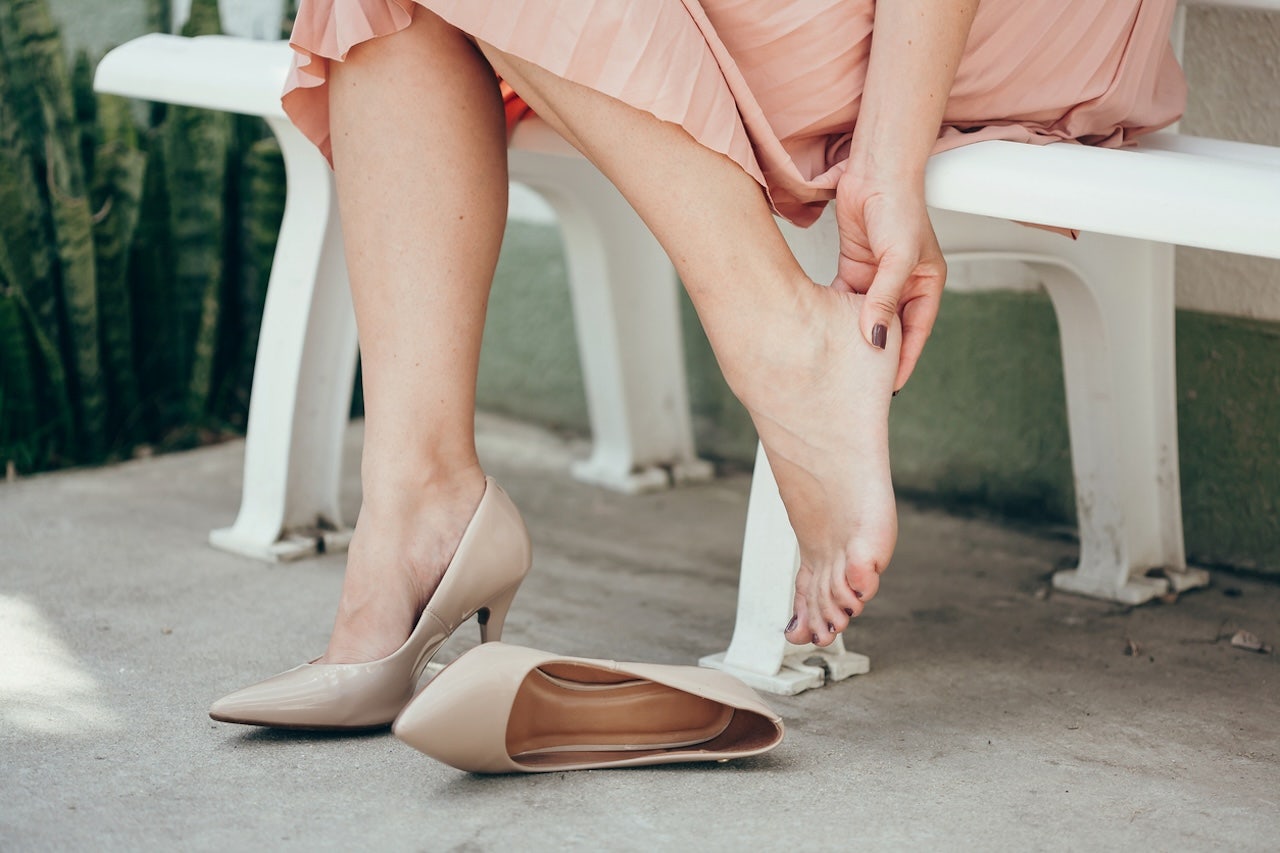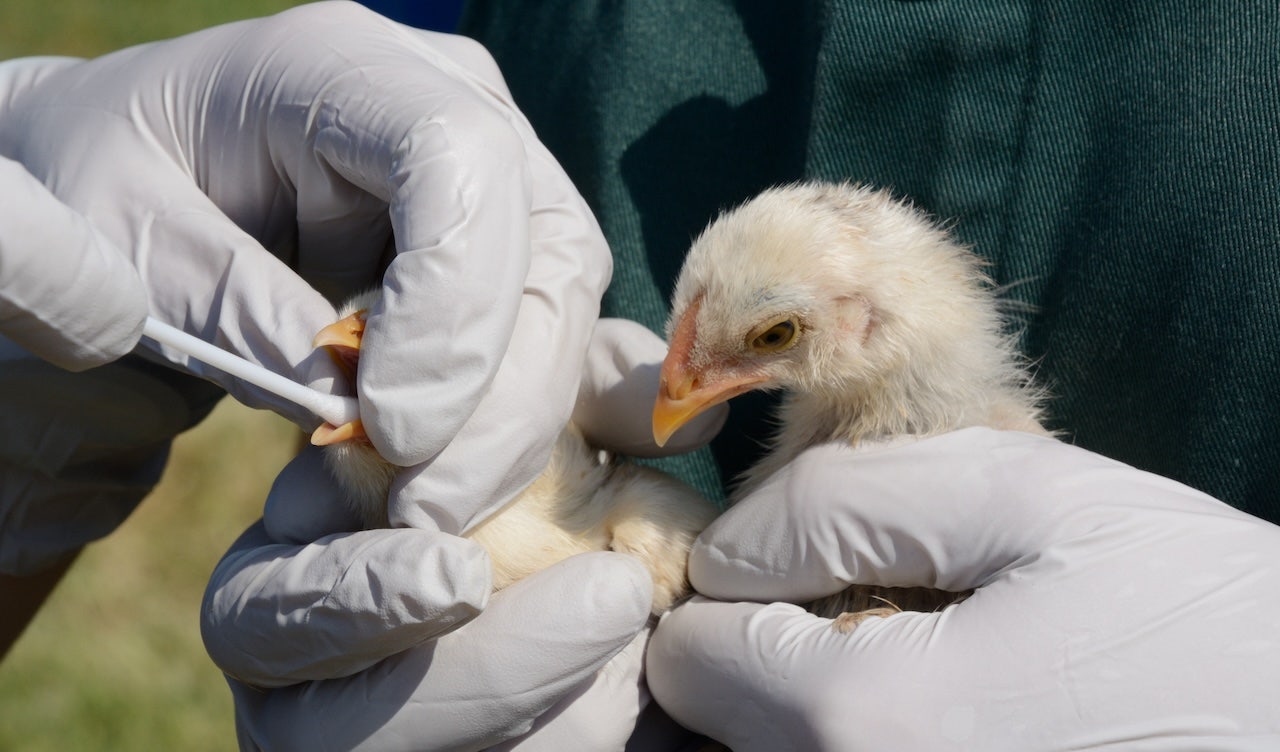Health
Ask a doctor: ‘What should I do about foot blisters?’

Got blisters? Here are answers.
Painful foot blisters can put a damper very quickly on vacation plans, exercise or even daily errands — but there are steps you can take to help them heal as quickly as possible.
Fox News Digital reached out to two podiatrists for their professional advice, including treatment of existing blisters and prevention of future sores.
ASK A DOCTOR: ‘HOW CAN I GET RID OF A COLD SORE AS QUICKLY AS POSSIBLE?’
Here’s how to put your best foot forward this summer.
What causes foot blisters?
In most cases, blisters develop on the feet due to ill-fitting shoes — but they can also stem from medical conditions.
Painful foot blisters can quickly put a damper on vacation plans, exercise or even daily errands — but there are steps you can take to help them heal as quickly as possible. (iStock)
Excessive friction is the most common cause, according to Dr. Alex Kor, a podiatrist with Hendricks Regional Health in Danville, Indiana.
This can come from increased activity in a short period of time, often from wearing new shoes that haven’t been broken in yet, the doctor told Fox News Digital.
EXPERTS WEIGH IN ON THE BENEFITS, RISKS OF USING CASTOR OIL FOR WEIGHT LOSS
Blisters can also occur when a bony pressure point, such as a bunion, gets too much friction from a new shoe or excessive activity in a short period of time.
Other potential causes include going without socks, wearing worn-out socks or choosing improper shoes that do not offload a source of pressure, Kor warned.

Excessive friction is the most common cause of blisters, according to a podiatrist. (iStock)
Some medical issues may also cause blisters.
“Depending on the patient’s medical status, conditions like diabetes and neuropathy can be the cause,” Kor told Fox News Digital.
“Regardless of the reason for the blister, patients who have poor blood flow to the feet, diabetes or neuropathy should likely consider seeing a podiatrist.”
Ways to treat a foot blister
If you do develop a foot blister, keeping it clean will speed up the healing process, experts say.
“It is highly suggested to cleanse the blister with soapy water, dry the area and cover it with a dressing on a daily basis,” said Kor.
SUNBURN SOS: 7 TIPS TO SOOTHE YOUR SUN-DAMAGED SKIN, ACCORDING TO A WELLNESS EXPERT
It’s not a good idea to skip the dressing and allow the site to “get air,” the doctor said.
If your foot blister was due to friction, Kor recommended avoiding the shoes or activity that caused the problem.

“It is highly suggested to cleanse the blister with soapy water, dry the area and cover with a dressing on a daily basis,” a podiatrist said. (iStock)
If a blister is accompanied by itching, there is the strong possibility that fungus could be the culprit, according to Kor.
“A topical over-the-counter antifungal cream or ointment is suggested if the fungus is on the top, bottom or side of foot, and an antifungal powder is suggested if the blister is between the toes,” he advised.
When should you seek medical attention?
Patients should see a doctor if they have poor blood flow to the feet, diabetes, neuropathy or a history of previous amputations, according to Kor.
CLICK HERE TO SIGN UP FOR OUR HEALTH NEWSLETTER
A doctor should also be involved if the blisters are accompanied by chills, fever, night sweats and/or red streaks coming from the area, which can be signs of infection.
You should also call a doctor if the blister has pus or yellow drainage; if the surrounding skin is red, hot and swollen; or if the blister is caused by a sunburn or frostbite, according to Dr. Saylee Tulpule, a podiatrist with Foot and Ankle Specialists of the Mid-Atlantic in the Washington, D.C. metro area.
Preventing blisters during summer travel
If your summer travel plans involve going to theme parks, hiking or lots of walking, proper foot care is essential to prevent blisters, experts agree.

“It is also important to carry a first-aid kit during travel to manage any bleeding or pain, including topical antibiotic, gauze, tape and bandages,” an expert advised. (iStock)
“To prevent blisters during summer travel, it is important to wear properly fitted shoes or sandals,” Tulpule told Fox News Digital.
“I always tell my patients to visit a shoe store or running store and find the right length and width — and always break in new shoes for three to four weeks prior to traveling.”
For more Health articles, visit www.foxnews/health
To further protect feet, Tulpule recommended adding moleskin padding to shoes or taping it to the skin to prevent rubbing.
“It is also important to carry a first-aid kit during travel to manage any bleeding or pain, including topical antibiotics, gauze, tape and bandages,” she added.

Health
One state leads country in human bird flu with nearly 40 confirmed cases

A child in California is presumed to have H5N1 bird flu, according to the San Francisco Department of Public Health (SFDPH).
As of Dec. 23, there had been 36 confirmed human cases of bird flu in the state, according to the California Department of Public Health (CDPH).
This represents more than half of the human cases in the country.
LOUISIANA REPORTS FIRST BIRD FLU-RELATED HUMAN DEATH IN US
The latest pediatric patient, who lives in San Francisco, experienced fever and conjunctivitis (pink eye) as a result of the infection.
The unnamed patient was not hospitalized and has fully recovered, according to the SFDPH.
A child in California is presumed to have H5N1 bird flu, according to the San Francisco Department of Public Health. (iStock)
The child tested positive for bird flu at the SFDPH Public Health Laboratory. The U.S. Centers for Disease Control and Prevention (CDC) will perform additional tests to confirm the result.
CLICK HERE TO SIGN UP FOR OUR HEALTH NEWSLETTER
It is not yet known how the child was exposed to the virus and an investigation is ongoing.
“I want to assure everyone in our city that the risk to the general public is low, and there is no current evidence that the virus can be transmitted between people,” said Dr. Grant Colfax, director of health, in the press release.
BIRD FLU PATIENT HAD VIRUS MUTATIONS, SPARKING CONCERN ABOUT HUMAN SPREAD
“We will continue to investigate this presumptive case, and I am urging all San Franciscans to avoid direct contact with sick or dead birds, especially wild birds and poultry. Also, please avoid unpasteurized dairy products.”
Samuel Scarpino, director of AI and life sciences and professor of health sciences at Northeastern University in Boston, is calling for “decisive action” to protect individuals who may be in contact with infected livestock and also to alert the public about the risks associated with wild birds and infected backyard flocks.

An infectious diseases expert called for “decisive action” to alert the public about the risks associated with wild birds and infected backyard flocks. (iStock)
“While I agree that the risk to the broader public remains low, we continue to see signs of escalating risk associated with this outbreak,” he told Fox News Digital.
Experts have warned that the possibility of mutations in the virus could enable person-to-person transmission.
“While the H5N1 virus is currently thought to only transmit from animals to humans, multiple mutations that can enhance human-to-human transmission have been observed in the severely sick American,” Dr. Jacob Glanville, CEO of Centivax, a San Francisco biotechnology company, told Fox News Digital.

As of Jan. 10, there have been a total of 707 infected cattle in California, per reports from the California Department of Food and Agriculture. (iStock)
“This highlights the requirement for vigilance and preparation in the event that additional mutations create a human-transmissible pandemic strain.”
As of Jan. 10, there have been a total of 707 infected cattle in California, per reports from the California Department of Food and Agriculture (CDFA).
For more Health articles, visit www.foxnews.com/health
In the last 30 days alone, the virus has been confirmed in 84 dairy farms in the state.
Health
Chronic Pain Afflicts Billions of People. It’s Time for a Revolution.

“In the beginning, everyone thought they were going to find this one breakthrough pain drug that would replace opioids,” Gereau said. Increasingly, though, it’s looking like chronic pain, like cancer, could end up having a range of genetic and cellular drivers that vary both by condition and by the particular makeup of the person experiencing it. “What we’re learning is that pain is not just one thing,” Gereau added. “It’s a thousand different things, all called ‘pain.’”
For patients, too, the landscape of chronic pain is wildly varied. Some people endure a miserable year of low-back pain, only to have it vanish for no clear reason. Others aren’t so lucky. A friend of a friend spent five years with extreme pain in his arm and face after roughhousing with his son. He had to stop working, couldn’t drive, couldn’t even ride in a car without a neck brace. His doctors prescribed endless medications: the maximum dose of gabapentin, plus duloxetine and others. At one point, he admitted himself to a psychiatric ward, because his pain was so bad that he’d become suicidal. There, he met other people who also became suicidal after years of living with terrible pain day in and day out.
The thing that makes chronic pain so awful is that it’s chronic: a grinding distress that never ends. For those with extreme pain, that’s easy to understand. But even less severe cases can be miserable. A pain rating of 3 or 4 out of 10 sounds mild, but having it almost all the time is grueling — and limiting. Unlike a broken arm, which gets better, or tendinitis, which hurts mostly in response to overuse, chronic pain makes your whole world shrink. It’s harder to work, and to exercise, and even to do the many smaller things that make life rewarding and rich.
It’s also lonely. When my arms first went crazy, I could barely function. But even after the worst had passed, I saw friends rarely; I still couldn’t drive more than a few minutes, or sit comfortably in a chair, and I felt guilty inviting people over when there wasn’t anything to do. As Christin Veasley, director and co-founder of the Chronic Pain Research Alliance, puts it: “With acute pain, medications, if you take them, they get you over a hump, and you go on your way. What people don’t realize is that when you have chronic pain, even if you’re also taking meds, you rarely feel like you were before. At best, they can reduce your pain, but usually don’t eliminate it.”
A cruel Catch-22 around chronic pain is that it often leads to anxiety and depression, both of which can make pain worse. That’s partly because focusing on a thing can reinforce it, but also because emotional states have physical effects. Both anxiety and depression are known to increase inflammation, which can also worsen pain. As a result, pain management often includes cognitive behavioral therapy, meditation practice or other coping skills. But while those tools are vital, it’s notoriously hard to reprogram our reactions. Our minds and bodies have evolved both to anticipate pain and to remember it, making it hard not to worry. And because chronic pain is so uncomfortable and isolating, it’s also depressing.
Health
7 blood pressure mistakes that could be throwing off your readings

Several key mistakes could throw off the accuracy of blood pressure readings for people who take them at home.
The average “normal” blood pressure is 120/80, according to the American Heart Association.
Almost half of all U.S. adults have elevated blood pressure (systolic pressure between 120 and 19 and diastolic pressure less than 80). High blood pressure (hypertension, which is when the systolic pressure is between 130 and 139 or diastolic pressure is between 80 and 89) can raise the risk of heart attack and stroke if left untreated, per the AHA.
JUST 5 MINUTES OF EXERCISE COULD REDUCE HIGH BLOOD PRESSURE, STUDY FINDS
“It is very common to see patients with bad data,” said Dr. Bradley Serwer, a Maryland-based cardiologist and chief medical officer at VitalSolution, an Ingenovis Health company that offers cardiovascular and anesthesiology services to hospitals.
The average “normal” blood pressure is 120/80, according to the American Heart Association. (iStock)
“It is essential to follow the proper standardized instructions.”
The cardiologist shared with Fox News Digital the following common mistakes he often sees patients make when monitoring their blood pressure.
1. Using the wrong arm position
Certain arm positions can lead to inflated results and misdiagnoses of hypertension. This was supported by recent research from Johns Hopkins Medicine.
BLOOD PRESSURE IS ‘HIGHER THAN NORMAL’ FOR 1 IN 7 KIDS, SAYS AMERICAN HEART ASSOCIATION
People who rested their arms on their laps drove up the top number in the blood pressure reading (systolic pressure) by nearly 4 mmHg, while leaving their arm hanging at their side increased it by nearly 7 mmHg.
For the most accurate results, the guidelines are to rest the arm on a desk or another firm surface at the same level as the heart, Serwer told Fox News Digital.
2. Sitting in the wrong position
“The proper position is to sit upright with your feet on the floor and your legs uncrossed, resting your arm on a flat surface that is level with your heart,” Serwer advised.

Certain arm positions can lead to inflated results and misdiagnoses of hypertension, research has shown. (iStock)
3. Using the wrong type or size of cuff
If the cuff is too large or small, measurements will be abnormal, the cardiologist cautioned.
“Most blood pressure monitors use either an arm cuff or a wrist cuff,” he said. “Arm cuffs tend to be more accurate and require fewer steps to ensure accuracy.”
4. Not calibrating the cuff
Serwer said he typically asks all patients to bring their home cuff to the office, where he first measures their blood pressure manually and then uses the patient’s cuff.
“We can then assess the accuracy of their cuff,” he said.
5. Not allowing enough time to equilibrate
The most accurate results are obtained after sitting in a low-stress environment for five minutes, Serwer noted.
“Know your blood pressure, even if you are healthy.”
6. Drinking caffeine beforehand
“Avoid stimulants before measuring your pressure, as caffeine will raise it,” Serwer said.
7. Checking at different times of day
When taking blood pressure, Serwer recommends checking it twice and waiting at least one minute between measurements.
“Blood pressure fluctuates throughout the day, so checking your pressure at the same time each day gives us a better trend,” he added.
Serwer also advises his patients to track their blood pressure readings in a log.

“If the average blood pressure reading is greater than 130/80, they have stage I hypertension and should be evaluated by their primary care provider,” a cardiologist said. (iStock)
“If the average blood pressure reading is greater than 130/80, they have stage I hypertension and should be evaluated by their primary care provider,” he said.
“If their blood pressure is greater than 180/100 or if they have symptoms of chest pain, shortness of breath or severe headache, they should seek immediate attention.”
CLICK HERE TO SIGN UP FOR OUR HEALTH NEWSLETTER
Even if there are no other symptoms other than high blood pressure, Serwer emphasizes that people shouldn’t wait until they have complications before treating hypertension.
“Heart attacks, strokes, renal failure and peripheral vascular disease can often be avoided with early interventions,” he said.

In most cases, making lifestyle changes such as improving your diet, exercising regularly and maintaining a healthy weight can help keep blood pressure within a safe range, according to the AHA. (iStock)
“Know your blood pressure, even if you are healthy.”
In most cases, making lifestyle changes such as improving your diet, exercising regularly and maintaining a healthy weight can help keep blood pressure within a safe range, according to the AHA.
For more Health articles, visit www.foxnews.com/health
When necessary, a doctor can provide guidance on medications to treat hypertension that does not respond to lifestyle changes.
-

 Politics1 week ago
Politics1 week agoNew Orleans attacker had 'remote detonator' for explosives in French Quarter, Biden says
-

 Politics1 week ago
Politics1 week agoCarter's judicial picks reshaped the federal bench across the country
-

 Politics1 week ago
Politics1 week agoWho Are the Recipients of the Presidential Medal of Freedom?
-

 Health1 week ago
Health1 week agoOzempic ‘microdosing’ is the new weight-loss trend: Should you try it?
-

 World1 week ago
World1 week agoSouth Korea extends Boeing 737-800 inspections as Jeju Air wreckage lifted
-
/cdn.vox-cdn.com/uploads/chorus_asset/file/25822586/STK169_ZUCKERBERG_MAGA_STKS491_CVIRGINIA_A.jpg)
/cdn.vox-cdn.com/uploads/chorus_asset/file/25822586/STK169_ZUCKERBERG_MAGA_STKS491_CVIRGINIA_A.jpg) Technology3 days ago
Technology3 days agoMeta is highlighting a splintering global approach to online speech
-

 News1 week ago
News1 week agoSeeking to heal the country, Jimmy Carter pardoned men who evaded the Vietnam War draft
-

 News1 week ago
News1 week agoTrump Has Reeled in More Than $200 Million Since Election Day













